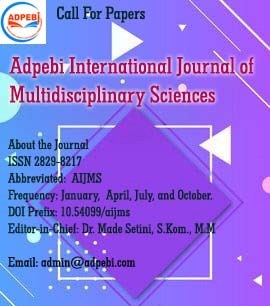Tourist Experience Model Saung Ciburial Tourism Village
DOI:
https://doi.org/10.54099/aijms.v1i2.241Abstract
Purpose – This study aims to analyze the S-O-R Model in the Ciburial tourism village in Garut Regency with the dimensions of Experience: 4Es yaitu Education, Entertaintment, Esthetics dan Escapism, affect the intervening variable Feeling of Happiness (fun) and its impact on the dependent variable Behavioral Intention. So that it can explain these factors in encouraging tourist attraction to visit the Ciburial tourism village of Garut Regency in the Covid-19 situation.
Methodology/approach – The research method used is quantitative with an explanatory research design. The population in this study were tourists from the Tourism Village of Garut Regency, amounting to 718 visitors with a total sample of 195 people.
Findings – It was found that the influence of the independent variables Experience 4Es, namely Education (X1), Entertainment (X2), Esthetics (X3) and Escapism (X4), affect the intervening variable feeling of happiness (fun) (Y) and its impact on the dependent variable Behavioral Intention (Z).
Novelty/value – As the S-O-R model has become an important factor in tourist villages over the past few years, it is very important to understand how to retain visitors. Keywords Experience, fun, promotion, Behavioral Intention, Tourism Village.
References
Abu Bakar MS. (2018). PSIKOLOGI TRANSPERSONAL; Mengenal Konsep Kebahagiaan dalam Psikologi Oleh Abu Bakar MS. Psikologi Transpersonal, 8(2), 162–180.
Asilah Emir, Hazwani Halim, Asyikin Hedre, Dahlan Abdullah*, Azila Azmi, S. B. M. K. (2016). Factors Influencing Online Hotel Booking Intention: A Conceptual Framework from Stimulus-Organism-Response Perspective. International Academic Research Journal of Business and Technology, 2(2), 129–134.
Bagdare, S., & Jain, R. (2013). Measuring retail customer experience. International Journal of Retail and Distribution Management, 41(10), 790–804. https://doi.org/10.1108/IJRDM-08-2012-0084
Chan, T. K. H. and Cheung, C. M. K. and Lee, Z. W. Y. (2017). The state of online impulse-buying research : a literature analysis. Information Management, 54(2), 204–217. http://dx.doi.org/10.1037/xge0000076
Chen, X., Cheng, Z. feng, & Kim, G. B. (2020). Make it memorable: Tourism experience, fun, recommendation and revisit intentions of Chinese outbound tourists. Sustainability (Switzerland), 12(5), 1–24. https://doi.org/10.3390/su12051904
Dedeoglu, B. B., Bilgihan, A., Ye, B. H., Buonincontri, P., & Okumus, F. (2018). The impact of servicescape on hedonic value and behavioral intentions: The importance of previous experience. International Journal of Hospitality Management, 72(April 2017), 10–20. https://doi.org/10.1016/j.ijhm.2017.12.007
Effendy, O. U. (2003). Ilmu, teori dan filsafat komunikasi.
Fernandes, T., & Cruz, M. (2016). Dimensions and outcomes of experience quality in tourism: The case of Port wine cellars. Journal of Retailing and Consumer Services, 31, 371–379. https://doi.org/10.1016/j.jretconser.2016.05.002
Güzel, F. Ö. (2014). The Dimensions of Tour Experience, Emotional Arousal, and Post-experience Behaviors: A Research on Pamukkale in Turkey. Procedia - Social and Behavioral Sciences, 150, 521–530. https://doi.org/10.1016/j.sbspro.2014.09.069
Hosany, S., & Witham, M. (2010). Dimensions of cruisers’ experiences, satisfaction, and intention to recommend. Journal of Travel Research, 49(3), 351–364. https://doi.org/10.1177/0047287509346859
Hutama, Christanto Leoma & Subagio, H. (2014). Analisa Pengaruh Dining Experience Terhadap Behavioral Intention Dengan Customer Satisfaction Sebagai Variabel Intervening. Jurnal Manajemen Pemasaran, 2(1).
Indrianita, A. (2016). Pengaruh Customer Experience terhadap Memories dan Customer Loyalty Hotel Royal Senyiur Resort Pasuruan. Calyptra, 2(2), 1–12.
Iskamto, dedi, Arhipen Yapentra, Elida Gultom, Misdawati, Wetri Febrina, Budi santosa, and A. T. Bon. (2021). “The Exploratory Factor Analysis on Firms Performance of Micro and Small Enterprises.” in Proceedings of the 11th Annual International Conference on Industrial Engineering and Operations Management. Singapore: IEOM Society International.
Kim, M. J., Lee, C. K., & Jung, T. (2020). Exploring Consumer Behavior in Virtual Reality Tourism Using an Extended Stimulus-Organism-Response Model. Journal of Travel Research, 59(1), 69–89. https://doi.org/10.1177/0047287518818915
Kim, S., Cha, J., Knutson, B. J., & Beck, J. A. (2011). Development and testing of the Consumer Experience Index (CEI). Managing Service Quality: An International Journal, 21(2), 112–132. https://doi.org/10.1108/09604521111113429
Luturlean, B. S., Hurriyati, R., Wibowo, L. A., & Anggadwita, G. (2018). Influencing factors in customers’ intention to re-visit resort hotels: The roles of customer experience management and customer value. Contributions to Management Science, 191–207. https://doi.org/10.1007/978-3-319-59282-4_12
Prayag, G., Hosany, S., & Odeh, K. (2013). The role of tourists’ emotional experiences and satisfaction in understanding behavioral intentions. Journal of Destination Marketing and Management, 2(2), 118–127. https://doi.org/10.1016/j.jdmm.2013.05.001
Purwianti, L., & Tio, K. (2017). Faktor-Faktor Yang Mempengaruhi Behavioural Intention. Jurnal Manajemen Maranatha, 17(1), 15. https://doi.org/10.28932/jmm.v17i1.415
Zhara K, M., & Baiquni, M. (2017). Pengalaman Berwisata Menggunakan Google Maps di Destinasi Pariwisata Yogyakarta. Jurnal Bumi Indonesia, Volume 6 N(2017), 8. http://lib.geo.ugm.ac.id/ojs/index.php/jbi/article/view/777/750
Downloads
Published
How to Cite
Issue
Section
License
Copyright (c) 2022 Adpebi International Journal of Multidisciplinary Sciences

This work is licensed under a Creative Commons Attribution-NonCommercial 4.0 International License.









